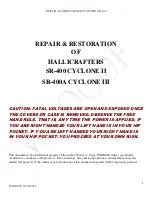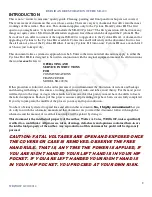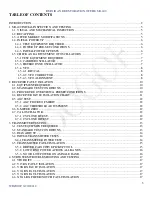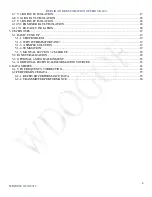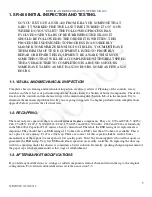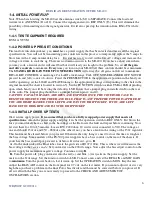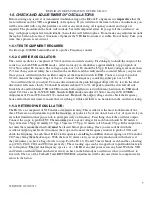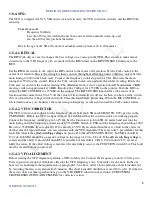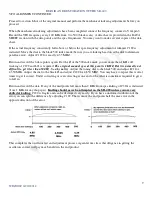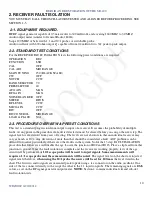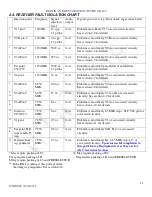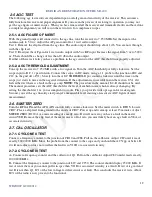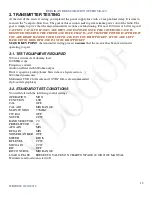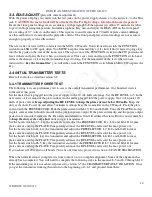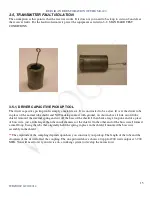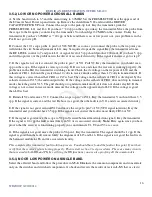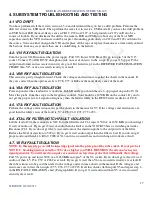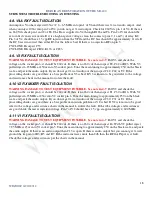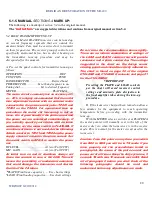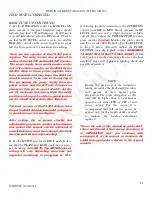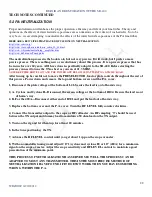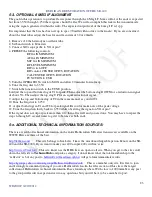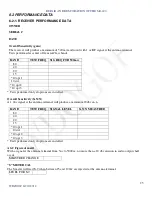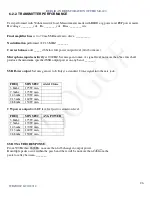
REPAIR AND RESTORATION OF THE SR-400
12
WDØGOF 6/22/20014
2-5 AGC TEST
The following agc test results are dependent upon overall gain and sensitivity of the receiver. This assumes a
fully functional receiver and proper alignment. If you are in the process of restoring to operation you may not
get the agc figure of merit in spec. When you have removed all the receiver and transmitter faults and have done
a completer alignment you will re-run these two tests for compliance to spec.
2-5-1. AGC FIGURE OF MERIT
With the ground jumper still connected to the agc line, tune the receiver to 7.250 MHz. Set the input at the
antenna jack to 5.0 uv. Adjust the AF gain control for 1 watt audio output.
Test 1: Remove the clip lead from the agc line. The audio output should drop about 1 db. You are now through
with the clip lead.
Test 2: Re-adjust the AF gain for 1 watt audio output with 5 uv RF input. Increase the signal from 5 uv to 5000
uv. There should be a change of less than 10 db in the audio output.
If either of these tests fails you have a problem in the agc circuit or the AGC threshold is improperly adjusted.
2-5-2. AGC THRESHOLD ADJUSTMENT
Tune up the receiver to 7.250 MHz with a 1uv signal in. Turn the AGC threshold pot fully clockwise. Set the
scope input to DC, 1v per division. Connect the scope, in DC mode, using a 1:1 probe to the junction of R2 and
C12 (in the grid ckt of V1). Slowly turn the AGC THRESHOLD pot counter-clockwise until the trace on the
scope just starts to move in the negative direction. If the adjustment is successful re-run the tests in 2-5-1 if it
fails either test there is a fault in the agc amp.
NOTE:
The procedure in the manual, 8-4-D should not be used.
The manual procedure sets the AGC threshold at the level of ambient noise which is always changing. By
setting the threshold at 1 uv you accomplish two tasks. First, you provide wide open gain for weak signals.
Second, you set the agc linearity start point at a measurable level insuring an accurate AGC figure of merit
measurement.
2-6. S-METER ZERO
Turn the RF GAIN and the AF GAIN controls fully counter-clockwise. Set the meter switch to RFO S. Locate
CR17. Place a clip lead from ground to the anode of CR17. Power up and warm up at least 15 minutes. Adjust
METER ZERO (R120) for a meter reading of exactly zero. If it will not zero you have a fault in the meter
circuit V8B. Remove the clip lead, if the meter moves off of zero you most likely have an agc fault in V8A, or
associated circuitry.
2-7. CAL OSCILLATOR
2-7-1. CYCLONE II TEST
Connect a frequency counter to the junction of CR10 and C88. Pull on the calibrator. Adjust C89 until it reads
exactly 100.00000 KHz. Move the probe from the counter to the scope and you should have 25vpp or better. If
it will not adjust or does not oscillate the fault is in V11B or associated circuitry.
2-7-2. CYCLONE III TEST
A
.
Connect a frequency counter and the collector of Q1. Pull on the calibrator Adjust C89 until it reads exactly
100.00000 KHz
B
.
Connect the frequency counter to the junction of L29 and C250. The counter should display 25.000 KHz. If
test A is not there or you cannot pull it in spec then V11B or associated circuitry is at fault. If test A is good and
test B is not then Q1, IC1 or the low voltage rectifier circuit is at fault. This concludes the receiver tests. About
80% of the radio is now proven to be functional.

